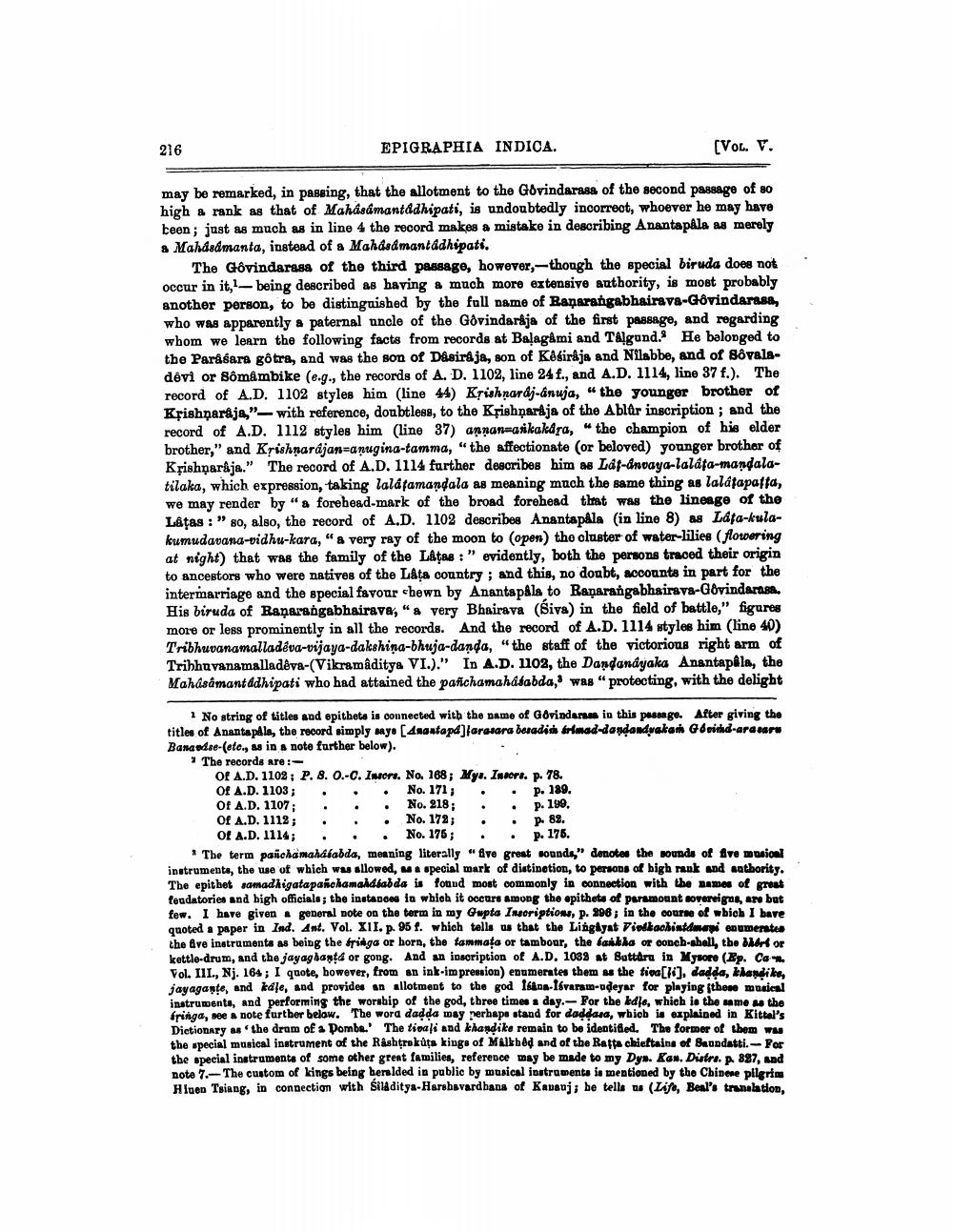________________
216
EPIGRAPHIA INDICA.
[Vol. V.
may be remarked, in passing, that the allotment to the Govindarass of the second passage of so high a rank as that of Mahasamantadhipati, is undoubtedly incorrect, whoever he may have been; just as much as in line 4 the record makes a mistake in describing Anantapkla as merely a Mahdsåmanta, instead of a Mahdedmantadhipati.
The Govindarasa of the third passage, however,-though the special biruda does not occur in it, being described as having a much more extensive authority, is most probably another person, to be distinguished by the full name of Raņarangabhairava-Govindarasa, who was apparently a paternal uncle of the Govindaraja of the first passage, and regarding whom we learn the following facts from records at Balagámi and Talgund. He belonged to tbo Parabara gôtre, and was the son of Disiraja, son of Kobiraja and Nilabbe, and of Sôvaladévi or Bômâmbike (e.g., the records of A. D. 1102, line 24 f., and A.D. 1114, line 37 f.). The record of A.D. 1102 styles him (line 44) Krishnardj-ánuja, “ the younger brother of Kộishnaraja," - with reference, doubtless, to the Krishnaraja of the Ablär inscription; and the record of A.D. 1112 styles him (line 37) annan=asikakdya," the champion of his elder brother," and Krishnarajan anugina-tamma, "the affectionate (or beloved) younger brother of Krishnaraja." The record of A.D. 1114 further describes him as Lát-anvaya-laláta-mandalatilaka, which expression, taking lalafamandala as meaning much the same thing as lalátapafta, we may render by "a forehead-mark of the broad forehead that was the lineage of the Latas : " so, also, the record of A.D. 1102 describes Anantapala (in line 8) as Láta-kulakumudavana-vidhu-kara, " & very ray of the moon to (open) the cluster of water-lilies (flowering at night) that was the family of the Latas :” evidently, both the persons traced their origin to ancestors who were natives of the Lata country; and this, no doubt, accounts in part for the intermarriage and the special favour chewn by Anantap&la to Ranarangabhairava-Govindarasa His biruda of Ranarangabhairava, "a very Bhairava (Biva) in the field of battle," figures more or less prominently in all the records. And the record of A.D. 1114 styles him (line 10) Tribhuvanamalladava-vijaya-dakshina-bhuja-danda, “the staff of the victorious right arm of Tribhuvanamalladêva-(Vikramaditya VI.)." In A.D. 1102, the Dandanayaka Anantapila, the Mahasamantadhipati who had attained the pafichamahasabda," was “protecting, with the delight
1 No string of titles and opitheta in connected with the name of Govindanes in this pasage. After giving the titles of Ananta pala, the record simply myo Anantapd]lararara boradise trimad-dandandyakan Goitid-aradaru Banand.se-(etc., as in a note further below). * The records are:
Of A.D. 1102: P. 8. O.-C. Istort. No. 168; Myu. Inari. p. 78. Of A.D. 1103;
. . No. 171; . . p. 189. Of A.D. 1107; . • No. 218; Of A.D. 1112 ; .
. No. 172; .
p. 82. Of A.D. 1114; .
No. 175; . . p. 176. * The term pafchamahdiabda, menning literally "five great sounds," denotes the sounds of five musical instruments, the we of which was allowed, ma special mark of distinction, to persons of bigh rauk and sathority, The epithet samadhigatapanohamaldlabda is found most commonly in connection with the names of great te datories and high officials; the instance la which it occurs among the epithets of paramount sovereigos, ane but few. I have given general note on the term in my Gupta Inseriptions, p. 298; in the course of which I bave quoted paper in Ind. Ant. Vol. XII. p. 95 f. which tells us that the Lingkyat Pialachisidan numeratea the dve instruments as being the fridge or born, the fammata or tambour, the banks or coneb-shell, the dirt or kettle-drum, and the jayag hand or gong. And an inscription of A.D. 1089 at Buttdru in Mysore (Ep. Ca.. Vol. IIL, Nj. 164; I quote, however, from an ink-impression) enumerates them as the tioa[], dadda, blandiks, jayagante, and kdle, and provides an allotment to the god Isana-Isvaram-odeyar for playing these musical instruments, and performing the worsbip of the god, three times a day. For the ldle, which is the same ne the fringa, ne a note further below. The word dadda may perhaps stand for daddasa, wbieb a explained in Kittel's Dictionary as the dram of a Dombe.' The finali and khandiko remain to be identified. The former of them wu the special musical instrument of the Rashtrakåta kings of Malkbed and of the Ratta chieftains of Baupdatti.- Por the special instrumenta of some other great families, reference may be made to my Dys. Kos. Distr. 897, and noto 7.-The custom of kings being heralded in public by musical instrumenta la mentioned by the Chinese pilgrim Hlup Tsiang, in connection with Siladitya-Harshavardhana of Kauaj, be tells u (Life, Beal's translation,




